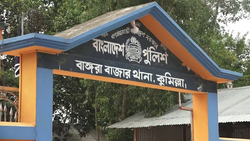Muradnagar Upazila
Muradnagar
মুরাদনগর | |
|---|---|
 Bangora Bazar Thana in Muradnagar Upazila | |
 | |
| Coordinates: 23°38.3′N 90°56′E / 23.6383°N 90.933°E | |
| Country | |
| Division | Chittagong |
| District | Comilla |
| Government | |
| • Upazila Chairman | Ahsanul Alam Sarkar |
| Area | |
| • Total | 340.73 km2 (131.56 sq mi) |
| Population | |
| • Total | 582,950 |
| • Density | 1,700/km2 (4,400/sq mi) |
| Demonym | Muradnagari |
| Time zone | UTC+6 (BST) |
| Postal code | 3540[2] |
| Area code | 08026[3] |
| Website | muradnagar |
Muradnagar (Bengali: মুরাদনগর, romanized: Muradnogor) is an upazila of the Comilla District in Chittagong Division, Bangladesh.[4]
History
[edit]In ancient times, the area was a part of the geopolitical region of Samatata ruled by the Rata dynasty. In the late 20th century, an irrigation canal was being dug in Urishwar, Paharpur Union. During the process, three copper plate inscriptions were discovered, surrounded by old potsherds, supposedly belonging to the Rata dynasty of Samatata.[5]
Muradnagar was previously known as Tholla. During the Mughal period, the area was under the Balda Khal pargana. After the arrival of the East India Company, a number of rebellions and peasant movements took place in Tholla. The 19th-century zamindar Mir Ashraf Ali Shirazi had a house in Tholla. In 1858, Tholla was established as a thana and in 1878, Tholla was renamed to Muradnagar. It was named after the revenue collector Mir Murad Ali.
Khwaja Salimullah, the Nawab of Dhaka donated towards the Muradnagar High School in 1903. In 1941, Captain Narendranath Dutta founded the Sreekail College, an institution of nationwide importance.[6]
Many Muradnagari freedom fighters were murdered during the Bangladesh Liberation War of 1971 during face-offs against the Pakistan Army. The thana was upgraded to an upazila in 1983.
Geography
[edit]Muradnagar is located at 23°38′19″N 90°55′57″E / 23.6385°N 90.9325°E. It has 101,809 households covering a total area of 340.73 km2.[7]
Demographics
[edit]According to the 2011 Census of Bangladesh, Muradnagar Upazila had 101,809 households and a population of 523,556. 144,345 (27.57%) were under 10 years of age. Muradnagar has a literacy rate (age 7 and over) of 48.81%, compared to the national average of 51.8%, and a sex ratio of 1115 females per 1000 males. 32,644 (6.24%) lived in urban areas.[9][10]
Administration
[edit]Muradnagar Upazila is divided into 22 union parishads: Akubpur, Andikot (Haidarabad), Babuti Para, Chapitala, Chhaliakandi, Dakshin Ramchandrapur, Darora, Dhamghar, Jahapur, Jatrapur, Kamalla, Muradnagar, Paharpur, Paschim Bangara, Paschim Nabipur, Paschim Porbadhair, Purba Bangara, Purba Nabipur, Purba Purbadhair, Sreekail, Tanki, and Uttar Ramchandrapur. The union parishads are subdivided into 153 mauzas and 301 villages.[7]
List of chairmen
[edit]| Name | Term |
|---|---|
| Jahangir Alam Sarkar | 1985 - 1986 |
| Pirzada Zahirul Alam Chishti | 1986 - 1991 |
| Harun Al-Rashid | 2009 - 2014 |
| Ahsanul Alam Sarkar | Present |
Notable people
[edit]- Mofazzal Hossain Kaikobad, Politician
- Rafiqul Islam Miah, Politician
- Yussuf Abdullah Harun, Politician
- Abdul Mannan, Politician
See also
[edit]References
[edit]- ^ National Report (PDF). Population and Housing Census 2022. Vol. 1. Dhaka: Bangladesh Bureau of Statistics. November 2023. p. 396. ISBN 978-9844752016.
- ^ "Bangladesh Postal Code". Dhaka: Bangladesh Postal Department under the Department of Posts and Telecommunications of the Ministry of Posts, Telecommunications and Information Technology of the People's Republic of Bangladesh. 20 October 2024.
- ^ "Bangladesh Area Code". China: Chahaoba.com. 18 October 2024.
- ^ Golam Kibria Bhuiyan (2012). "Muradnagar Upazila". In Sirajul Islam; Miah, Sajahan; Khanam, Mahfuza; Ahmed, Sabbir (eds.). Banglapedia: the National Encyclopedia of Bangladesh (Online ed.). Dhaka, Bangladesh: Banglapedia Trust, Asiatic Society of Bangladesh. ISBN 984-32-0576-6. OCLC 52727562. OL 30677644M. Retrieved 9 November 2024.
- ^ Muhammad Harunur Rashid (2012). "Rata Dynasty". In Sirajul Islam; Miah, Sajahan; Khanam, Mahfuza; Ahmed, Sabbir (eds.). Banglapedia: the National Encyclopedia of Bangladesh (Online ed.). Dhaka, Bangladesh: Banglapedia Trust, Asiatic Society of Bangladesh. ISBN 984-32-0576-6. OCLC 52727562. OL 30677644M. Retrieved 9 November 2024.
- ^ Golam Kibria Bhuiyan (2012). "Sreekail College". In Sirajul Islam; Miah, Sajahan; Khanam, Mahfuza; Ahmed, Sabbir (eds.). Banglapedia: the National Encyclopedia of Bangladesh (Online ed.). Dhaka, Bangladesh: Banglapedia Trust, Asiatic Society of Bangladesh. ISBN 984-32-0576-6. OCLC 52727562. OL 30677644M. Retrieved 9 November 2024.
- ^ a b "District Statistics 2011: Comilla" (PDF). Bangladesh Bureau of Statistics. Archived from the original (PDF) on 25 April 2015. Retrieved 14 July 2014.
- ^ Population and Housing Census 2022 - District Report: Cumilla (PDF). District Series. Dhaka: Bangladesh Bureau of Statistics. June 2024. ISBN 978-984-475-259-7.
- ^ "Bangladesh Population and Housing Census 2011 Zila Report – Comilla" (PDF). bbs.gov.bd. Bangladesh Bureau of Statistics.
- ^ "Community Tables: Comilla district" (PDF). bbs.gov.bd. Bangladesh Bureau of Statistics. 2011.
External links
[edit]- http://muradnagar.comilla.gov.bd/
- https://web.archive.org/web/20130503014930/http://www.bbs.gov.bd/webtestapplication/userfiles/image/Census2011/Chittagong/Commilla/Comilla_C04.pdf
- https://web.archive.org/web/20130503014204/http://www.bbs.gov.bd/webtestapplication/userfiles/image/Census2011/Chittagong/Commilla/Comilla%20at%20a%20glance.pdf
- https://web.archive.org/web/20131113172538/http://www.bbs.gov.bd/WebTestApplication/userfiles/Image/BBS/Socio_Economic.pdf
